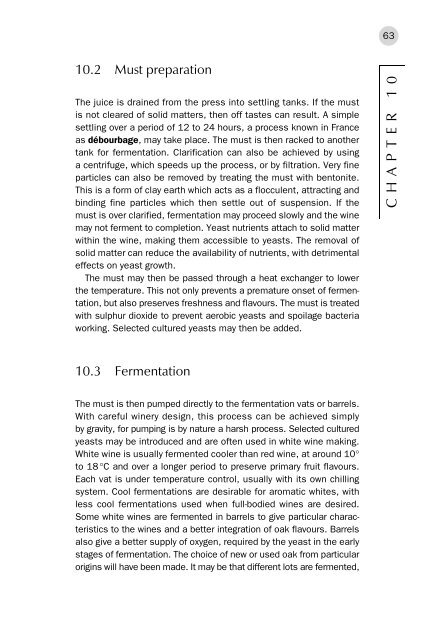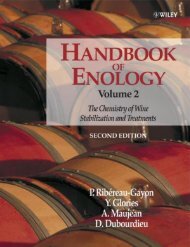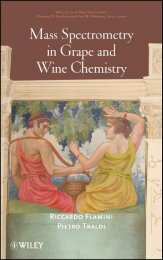Wine Production : Vine to Bottle - Vinum Vine
Wine Production : Vine to Bottle - Vinum Vine
Wine Production : Vine to Bottle - Vinum Vine
You also want an ePaper? Increase the reach of your titles
YUMPU automatically turns print PDFs into web optimized ePapers that Google loves.
63<br />
10.2 Must preparation<br />
The juice is drained from the press in<strong>to</strong> settling tanks. If the must<br />
is not cleared of solid matters, then off tastes can result. A simple<br />
settling over a period of 12 <strong>to</strong> 24 hours, a process known in France<br />
as débourbage, may take place. The must is then racked <strong>to</strong> another<br />
tank for fermentation. Clarification can also be achieved by using<br />
a centrifuge, which speeds up the process, or by filtration. Very fine<br />
particles can also be removed by treating the must with ben<strong>to</strong>nite.<br />
This is a form of clay earth which acts as a flocculent, attracting and<br />
binding fine particles which then settle out of suspension. If the<br />
must is over clarified, fermentation may proceed slowly and the wine<br />
may not ferment <strong>to</strong> completion. Yeast nutrients attach <strong>to</strong> solid matter<br />
within the wine, making them accessible <strong>to</strong> yeasts. The removal of<br />
solid matter can reduce the availability of nutrients, with detrimental<br />
effects on yeast growth.<br />
The must may then be passed through a heat exchanger <strong>to</strong> lower<br />
the temperature. This not only prevents a premature onset of fermentation,<br />
but also preserves freshness and flavours. The must is treated<br />
with sulphur dioxide <strong>to</strong> prevent aerobic yeasts and spoilage bacteria<br />
working. Selected cultured yeasts may then be added.<br />
CHAPTER 10<br />
10.3 Fermentation<br />
The must is then pumped directly <strong>to</strong> the fermentation vats or barrels.<br />
With careful winery design, this process can be achieved simply<br />
by gravity, for pumping is by nature a harsh process. Selected cultured<br />
yeasts may be introduced and are often used in white wine making.<br />
White wine is usually fermented cooler than red wine, at around 10°<br />
<strong>to</strong> 18 °C and over a longer period <strong>to</strong> preserve primary fruit flavours.<br />
Each vat is under temperature control, usually with its own chilling<br />
system. Cool fermentations are desirable for aromatic whites, with<br />
less cool fermentations used when full-bodied wines are desired.<br />
Some white wines are fermented in barrels <strong>to</strong> give particular characteristics<br />
<strong>to</strong> the wines and a better integration of oak flavours. Barrels<br />
also give a better supply of oxygen, required by the yeast in the early<br />
stages of fermentation. The choice of new or used oak from particular<br />
origins will have been made. It may be that different lots are fermented,
















